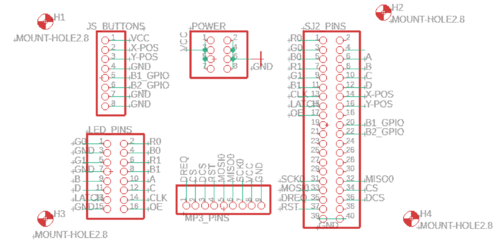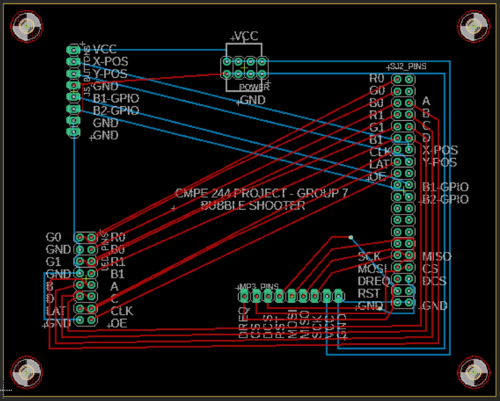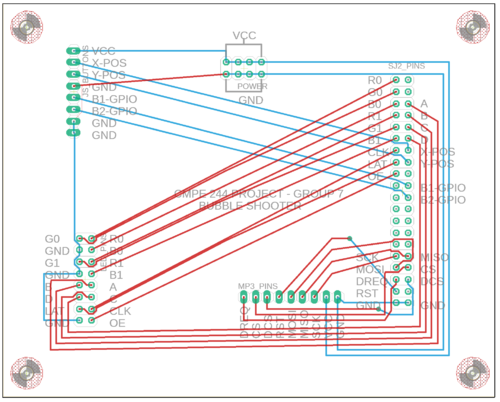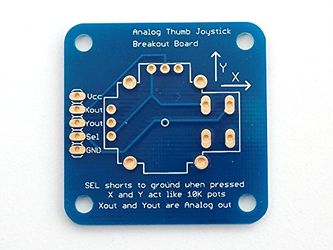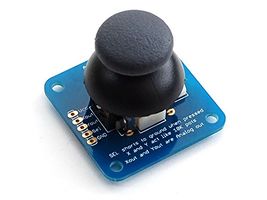Difference between revisions of "F20: Bubble Shooter"
Proj user7 (talk | contribs) (→Hardware Design & Implementation) |
Proj user7 (talk | contribs) (→Hardware Design & Implementation) |
||
| Line 349: | Line 349: | ||
! scope="row"| 2 | ! scope="row"| 2 | ||
| MP3-CS | | MP3-CS | ||
| − | | | + | | VS1053B Chip Select |
| Pin 0.22 | | Pin 0.22 | ||
|- | |- | ||
! scope="row"| 3 | ! scope="row"| 3 | ||
| MP3-DCS | | MP3-DCS | ||
| − | | | + | | VS1053B Data CS |
| Pin 0.0 | | Pin 0.0 | ||
|- | |- | ||
| Line 360: | Line 360: | ||
| MP3-RST | | MP3-RST | ||
| VS1053 Reset | | VS1053 Reset | ||
| − | | Pin 0. | + | | Pin 0.10 |
|- | |- | ||
! scope="row"| 5 | ! scope="row"| 5 | ||
| MOSI | | MOSI | ||
| SPI Bus (Master Output Slave Input) | | SPI Bus (Master Output Slave Input) | ||
| − | | Pin 0. | + | | Pin 0.18 |
|- | |- | ||
! scope="row"| 6 | ! scope="row"| 6 | ||
| MISO | | MISO | ||
| SPI Bus (Master Input Slave Output) | | SPI Bus (Master Input Slave Output) | ||
| − | | Pin 0. | + | | Pin 0.17 |
|- | |- | ||
! scope="row"| 7 | ! scope="row"| 7 | ||
| SCK | | SCK | ||
| SPI Clock | | SPI Clock | ||
| − | | Pin 0. | + | | Pin 0.15 |
|- | |- | ||
! scope="row"| 8 | ! scope="row"| 8 | ||
Revision as of 16:42, 12 December 2020
Contents
Abstract
Bubble shooter is an arcade game that has bubbles or balls present on the screen. The bubbles are of different colors and the goal is to clear them by forming a group of bubbles (3 or more) of the same color. Points are earned upon clearing the bubbles and increases with the number of bubbles cleared in a single shot. The player wins upon clearing the screen and loses when the bubbles touch the bottom of the screen.
Objectives & Introduction
Show a list of your objectives. This section includes the high-level details of your project. You can write about the various sensors or peripherals you used to get your project completed.
Team Members
Technical Responsibilities
|
Hisaam Hashim, Amiraj Nigam, Anirudh Ashrit, Akshat Bhutiani |
|---|---|
|
Anirudh Ashrit |
|
Hisaam Hashim |
|
Hisaam Hashim, Akshat Bhutiani |
|
Amiraj Nigam, Anirudh Ashrit |
|
Akshat Bhutiani |
|
Amiraj Nigam, Hisaam Hashim |
Administrative Responsibilities
|
Hisaam Hashim |
|---|---|
|
Akshat Bhutiani & Anirudh Ashrit |
|
Hisaam Hashim |
|
Amiraj Nigam & Anirudh Ashrit |
|
Akshat Bhutiani |
Schedule
| Week# | Start Date | End Date | Task | Status |
|---|---|---|---|---|
| 1 |
|
|
|
|
| 2 |
|
|
|
|
| 3 |
|
|
|
|
| 4 |
|
|
|
|
| 5 |
|
|
|
|
| 6 |
|
|
|
|
| 7 |
|
|
|
|
| 8 |
|
|
|
|
| 9 |
|
|
|
|
| 10 |
|
|
|
|
Bill Of Materials
| Item# | Part Description | Part Model & Vendor | Quantity | Cost |
|---|---|---|---|---|
| 1 | Microcontroller Boards | SJ2 Boards (Purchased from Preet Kang) | 1 | $50.00 |
| 2 | LED Matrix Display | RGB LED Matrix Panel - 32X64 | 1 | $55.00 |
| 3 | Audio decoder Breakout Board | MP3 PLayer Shield | 1 | $26.95 |
| 4 | Analog 2-axis Thumb Joystick | Analog 2-axis Joystick | 1 | $10.36 |
| 5 | Power Supply | 5V/3A Power Supply | 1 | $8.99 |
PCB Design
The board is designed to connect modules in the game directly. Autodesk's Eagle software is used to design the Schematics and Board layout. The board has 2 layers(Top and Bottom). JLCPCB is the manufacturer of the PCB board.
Hardware Design & Implementation
Analog Joystick
An ADA512 2-axis Analog Joystick and Button is used for controlling the movement of the launcher and shooting the ball. The data from the joystick is read using the ADC pins of the SJTwo board. The button switch is detected using a digital pin on the board.
VS1053B MP3 Decoder Interfacing
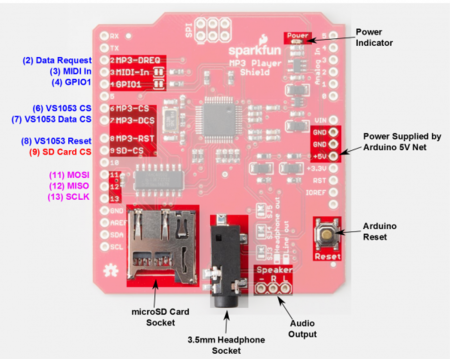
| Label | Name | Function | Pin Connection |
|---|---|---|---|
| 1 | MP3-DREQ | Decoder Data Request | Pin 0.1 |
| 2 | MP3-CS | VS1053B Chip Select | Pin 0.22 |
| 3 | MP3-DCS | VS1053B Data CS | Pin 0.0 |
| 4 | MP3-RST | VS1053 Reset | Pin 0.10 |
| 5 | MOSI | SPI Bus (Master Output Slave Input) | Pin 0.18 |
| 6 | MISO | SPI Bus (Master Input Slave Output) | Pin 0.17 |
| 7 | SCK | SPI Clock | Pin 0.15 |
| 8 | +5V | +5V | PCB Vout |
| 9 | GND | GND | GND |
Hardware Interface
In this section, you can describe how your hardware communicates, such as which BUSes used. You can discuss your driver implementation here, such that the Software Design section is isolated to talk about high-level workings rather than the inner working of your project.
Software Design
Show your software design. For example, if you are designing an MP3 Player, show the tasks that you are using, and what they are doing at a high level. Do not show the details of the code. For example, do not show the exact code, but you may show pseudocode and fragments of code. Keep in mind that you are showing the DESIGN of your software, not the inner workings of it.
Implementation
This section includes implementation, but again, not the details, just the high level. For example, you can list the steps it takes to communicate over a sensor, or the steps needed to write a page of memory onto SPI Flash. You can include sub-sections for each of your component implementations.
Testing & Technical Challenges
Describe the challenges of your project. What advice would you give yourself or someone else if your project can be started from scratch again? Make a smooth transition to the testing section and described what it took to test your project.
Include sub-sections that list out a problem and solution, such as:
<Bug/issue name>
Discuss the issue and resolution.
Conclusion
Conclude your project here. You can recap your testing and problems. You should address the "so what" part here to indicate what you ultimately learned from this project. How has this project increased your knowledge?
Project Video
Upload a video of your project and post the link here.
Project Source Code
References
Acknowledgement
Any acknowledgment that you may wish to provide can be included here.
References Used
List any references used in the project.
Appendix
You can list the references you used.
